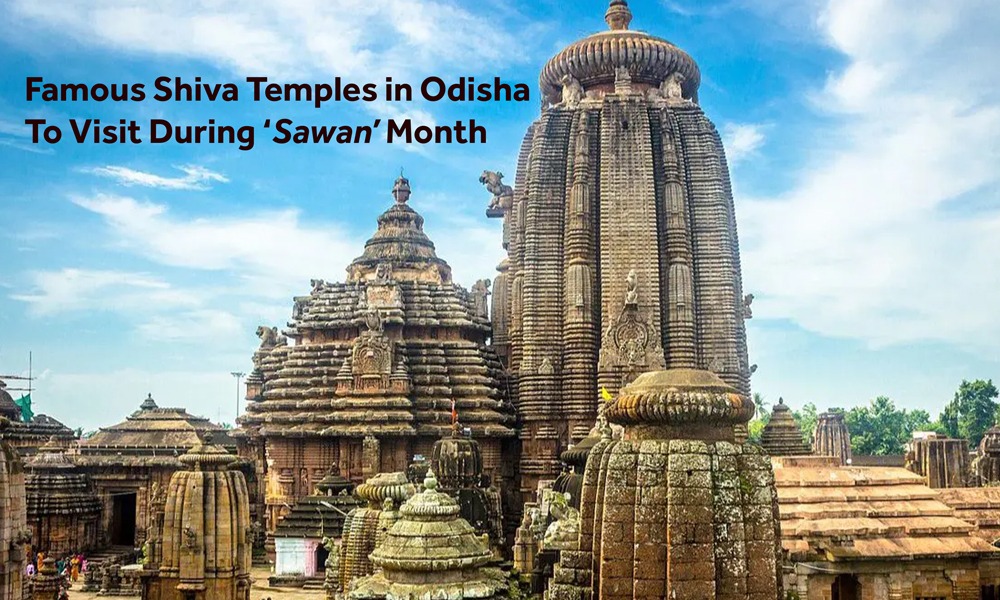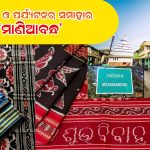The month of sawan resonates with the serene melodies of peace, purity, and tranquility. The air around us is filled with sacred energy, imparting a feeling of peace. It is time when Lord Shiva’s divine energy blesses us with everlasting happiness and devotees across the country seek his blessings to bring grace and goodness into their lives.
Lord Jagannath’s land is dotted with numerous temples of Lord Shiva, which await the devotees during the holy month of sawan. With the holy month now on, we bring you a list of some of the ancient Shiva temples, that you must surely visit to establish a peaceful connection with Mahadev.
Here are some of the most revered Shiva temples in Odisha that you should visit to receive Mahadev’s blessings in abundance!
Lingaraj Temple
As we begin the list, the first temple featured in this is one of the most well-known temples dedicated to Lord Shiva- Lingaraj Temple. The temple was built in the 11th century A.D. and is believed by Somvanshi king, Yayati-1.
Odisha is incomplete without a pilgrimage to the Lingaraj Temple, a towering 180-foot marvel of Hindu architecture. The temple is divided into four main sections: the Garba Griha (sanctum), YojanaMandapa (hall of prayers), Natya Mandapa (dance and music hall), and Bhoga Mandapa (prasad hall).
If you ever find yourself stressed and tired, a visit to this temple will immerse you in divine bliss. After your darshan, you can even embark on a leisurely drive around the nearby Bindusagar Lake or explore Ekmra Van, located on the western banks of the lake, where you’ll find a variety of trees that are associated with different deities possessing medicinal properties. This makes your sawan celebrations much more fruitful.
Kapilash Temple
During the month of sawan, there is a feeling of ecstasy in the hearts of all the devotees. You find people in hordes rushing to Lord Shiva and offering their prayers. Among one such temple is the famous Kapilash temple.
Located in the northeastern part of Dhenkanal, this temple draws countless pilgrims who come to offer their prayers. Constructed in 1246 C.E., the temple is a breathtaking architectural splendor, surrounded by scenic beauty. It also houses the idols of Jagamohan, Gangadevi, Kartikeya, Ganesha, and other deities, making it a spiritual haven. You need to climb about 1352 steps to reach the temple. It could be slightly hectic for you, but it is an experience you must have.
After your pooja, you can take a breath of some fresh air rejoicing in the scenic bliss that surrounds the temple. Take as many selfies as you want, with the beautiful hillocks in the the background!
Mukteshwara Temple
A quintessential example of Kalingan architecture, Mukteshwara Temple was constructed during the reign of the Somavamshi dynasty by King Yayati-1. If you are a devout follower of Lord Shiva, this temple is a must-visit, especially during the month of sawan when the divine energy of Shiva is at its peak.
The temple dates back to the 10th century and is nestled within the serene Siddharanya garden complex, a magnificent piece of architecture that attracts devotees and art enthusiasts alike.
Showcasing the beauty of our Kalingan architecture at its finest, the delicate carvings on the temple will be a treat for your eyes, as you might just immerse yourself in studying them in detail. The arched gateway is equally spectacular, and is undoubtedly the most prominent feature of the temple that takes your breath away!
Before Savan ends, do make it a point to visit the temple with your family and friends, for a refreshing change for your mind and soul.
Akhandalamani Temple
Situated 130 kilometers away from Bhadrak, the Akhandalamani Temple was built between 1830 and 1840 A.D. The temple is believed to be about 350 years old and was built during the reign of Raja Sri Niladri Samara Singha Mohapatra.
The temple, dedicated to Lord Shiva, has an interesting legend behind it. According to lore, a peasant once struck a granite stone with his axe, causing it to bleed. Astonished, he witnessed the blood turning into milk as a cobra appeared over the stone. This miraculous event led the king to build the temple, which has since become a site of deep reverence, especially during Mahashivaratri.
Being one of the major tourist attractions in Bhadrak, the temple plays a huge role in significantly impacting the economy!
Chandaneswar Temple
Odisha is blessed with numerous sacred sites that are home to Lord Shiva. Chandaneswar Temple in Balasore district is another gem that would be a place worth visiting in the month of sawan. Renowned for vibrant festivals like Chadak Mela and Chaitra Mela, this temple is an ideal destination for the holy month of sawan. Devotees flock to this holy site to experience the divine atmosphere and seek Lord Shiva’s blessings.
A huge annual fair during Pana Sankranti is organized here, attracting an enthusiastic crowd.
Huma Temple
Just as Italy has the Leaning Tower of Pisa, Odisha too has its leaning wonder—the Huma Temple. This ancient temple, dedicated to Lord Bimaleswar, is situated on the banks of the Mahanadi River in the village of Huma, which is 23 km away from Sambalpur. It was built by Ganga Vamsi Emperor Anangabhima Deva-III and later renovated by King Baliar Singh during 1660 A.D, the fifth Chauhan king of Sambalpur.
The true reason behind the temple’s tilt remains a mystery, even though it adds to its allure. Visitors are often fascinated by the temple’s resident fish, known as Kudo, believed to be a gift from Lord Shiva. These fish are sacred and undomesticated, seen as divine treasures. It is even believed that one who touches the fish may turn into a stone.
The interesting fact about the temple is, that not only the main temple but also every other structure surrounding it temple leans in different directions, elevating the curiosity of the visitors.
So when are you planning to visit the above-mentioned temples? Share your experience with us in our comment box!
Enjoy the holy bliss!
The month of sawan resonates with the serene melodies of peace, purity, and tranquility. The air around us is filled with sacred energy, imparting a feeling of peace. It is time when Lord Shiva’s divine energy blesses us with everlasting happiness and devotees across the country seek his blessings to bring grace and goodness into their lives.
Lord Jagannath’s land is dotted with numerous temples of Lord Shiva, which await the devotees during the holy month of sawan. With the holy month now on, we bring you a list of some of the ancient Shiva temples, that you must surely visit to establish a peaceful connection with Mahadev.
Here are some of the most revered Shiva temples in Odisha that you should visit to receive Mahadev’s blessings in abundance!
Lingaraj Temple
As we begin the list, the first temple featured in this is one of the most well-known temples dedicated to Lord Shiva- Lingaraj Temple. The temple was built in the 11th century A.D. and is believed by Somvanshi king, Yayati-1.
Odisha is incomplete without a pilgrimage to the Lingaraj Temple, a towering 180-foot marvel of Hindu architecture. The temple is divided into four main sections: the Garba Griha (sanctum), YojanaMandapa (hall of prayers), Natya Mandapa (dance and music hall), and Bhoga Mandapa (prasad hall).
If you ever find yourself stressed and tired, a visit to this temple will immerse you in divine bliss. After your darshan, you can even embark on a leisurely drive around the nearby Bindusagar Lake or explore Ekmra Van, located on the western banks of the lake, where you’ll find a variety of trees that are associated with different deities possessing medicinal properties. This makes your sawan celebrations much more fruitful.
Kapilash Temple
During the month of sawan, there is a feeling of ecstasy in the hearts of all the devotees. You find people in hordes rushing to Lord Shiva and offering their prayers. Among one such temple is the famous Kapilash temple.
Located in the northeastern part of Dhenkanal, this temple draws countless pilgrims who come to offer their prayers. Constructed in 1246 C.E., the temple is a breathtaking architectural splendor, surrounded by scenic beauty. It also houses the idols of Jagamohan, Gangadevi, Kartikeya, Ganesha, and other deities, making it a spiritual haven. You need to climb about 1352 steps to reach the temple. It could be slightly hectic for you, but it is an experience you must have.
After your pooja, you can take a breath of some fresh air rejoicing in the scenic bliss that surrounds the temple. Take as many selfies as you want, with the beautiful hillocks in the the background!
Mukteshwara Temple
A quintessential example of Kalingan architecture, Mukteshwara Temple was constructed during the reign of the Somavamshi dynasty by King Yayati-1. If you are a devout follower of Lord Shiva, this temple is a must-visit, especially during the month of sawan when the divine energy of Shiva is at its peak.
The temple dates back to the 10th century and is nestled within the serene Siddharanya garden complex, a magnificent piece of architecture that attracts devotees and art enthusiasts alike.
Showcasing the beauty of our Kalingan architecture at its finest, the delicate carvings on the temple will be a treat for your eyes, as you might just immerse yourself in studying them in detail. The arched gateway is equally spectacular, and is undoubtedly the most prominent feature of the temple that takes your breath away!
Before Savan ends, do make it a point to visit the temple with your family and friends, for a refreshing change for your mind and soul.
Akhandalamani Temple
Situated 130 kilometers away from Bhadrak, the Akhandalamani Temple was built between 1830 and 1840 A.D. The temple is believed to be about 350 years old and was built during the reign of Raja Sri Niladri Samara Singha Mohapatra.
The temple, dedicated to Lord Shiva, has an interesting legend behind it. According to lore, a peasant once struck a granite stone with his axe, causing it to bleed. Astonished, he witnessed the blood turning into milk as a cobra appeared over the stone. This miraculous event led the king to build the temple, which has since become a site of deep reverence, especially during Mahashivaratri.
Being one of the major tourist attractions in Bhadrak, the temple plays a huge role in significantly impacting the economy!
Chandaneswar Temple
Odisha is blessed with numerous sacred sites that are home to Lord Shiva. Chandaneswar Temple in Balasore district is another gem that would be a place worth visiting in the month of sawan. Renowned for vibrant festivals like Chadak Mela and Chaitra Mela, this temple is an ideal destination for the holy month of sawan. Devotees flock to this holy site to experience the divine atmosphere and seek Lord Shiva’s blessings.
A huge annual fair during Pana Sankranti is organized here, attracting an enthusiastic crowd.
Huma Temple
Just as Italy has the Leaning Tower of Pisa, Odisha too has its leaning wonder—the Huma Temple. This ancient temple, dedicated to Lord Bimaleswar, is situated on the banks of the Mahanadi River in the village of Huma, which is 23 km away from Sambalpur. It was built by Ganga Vamsi Emperor Anangabhima Deva-III and later renovated by King Baliar Singh during 1660 A.D, the fifth Chauhan king of Sambalpur.
The true reason behind the temple’s tilt remains a mystery, even though it adds to its allure. Visitors are often fascinated by the temple’s resident fish, known as Kudo, believed to be a gift from Lord Shiva. These fish are sacred and undomesticated, seen as divine treasures. It is even believed that one who touches the fish may turn into a stone.
The interesting fact about the temple is, that not only the main temple but also every other structure surrounding it temple leans in different directions, elevating the curiosity of the visitors.
So when are you planning to visit the above-mentioned temples? Share your experience with us in our comment box!
Enjoy the holy bliss!




